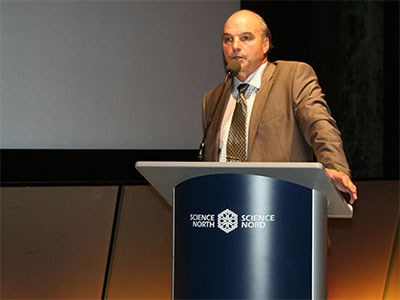KGHM International expects to have a decision on full funding for the Victoria Project in the Sudbury Basin by year’s end, along with a decision on whether to sink one or two shafts, chief project officer Warner Uhl told close to 150 mining suppliers at an information meeting organized by the Sudbury Area Mining Supply and Service Association this past summer.
“Are we going to spend $500 million or a billion? It’s not an easy decision,” said Uhl. “The issue we have is that the orebody is inferred. To get it to a resource, we have to drill 604 holes and we’ve only drilled 32, so it’s a quandary. Do we play it safe and take a couple of years longer to go into production, or do we sink two shafts on a gamble? This is the dilemma we’ve been facing for one and a half years.”
KGHM and the former owner of the project, Quadra FNX, have gone back and forth on the one- versus two-shaft development scenario. In 2011, Quadra FNX announced plans to sink two shafts concurrently, but the company was scooped up by Polish-based KGHM a year later, leading to long drawn out negotiations with Vale over back-in rights and milling.
Once that was resolved, “the race was on to develop it, and I think some sanity hit us when we realized the original plan was too expensive,” said Uhl. “We were just going to do an exploration shaft, but (more recently) our president asked us to take another look at what creates the best value.”
KGHM is spending approximately $30 million this year on engineering, sub-collar excavations, a collar foundation, a retaining wall for a sub-station and a mine water pond. Next year, it will spend either US$80 million or US$150 million, depending on the number of shafts it decides to sink.
If the decision is to go with one shaft, it will go down to the 1,400-metre level with ramping from that point on. “Then we’ll do some drilling from underground to get a better handle on the orebody and the deleterious metals,” said Uhl.
If the decision is to go with two shafts, one will go down to 1,800 metres, the other to 2,200 metres.
Shaft sinking will get underway in June 2016 if KGHM opts for two shafts, or in September 2016 if it decides on the single shaft option.
“The ore will be sent to Vale, but one of the concerns we have is the deleterious metals in the orebody,” said Uhl. “We have a very tight range when it comes to zinc, mercury and arsenic. If we’re over, Vale can reject the ore, so we’re trying to get a better understanding of the deleterious metals in the orebody.”
Drilling to date has produced estimates of 10.4 million tonnes of ore at 2 per cent nickel and 2 per cent copper.
The shaft-sinking contract was originally going to be awarded to KGHM’s own DMC Mining Services, but has gone to Cementation instead.
KGHM went to tender to test the market and had planned to award it to DMC, but DMC was busy with BHP Billiton’s Jansen project in Saskatchewan and some salt mines in the U.S., and a planned joint venture with another company failed to materialize.
“To be honourable, I paid Cementation for their tendering costs,” said Uhl. “I wrote them a cheque for $200,000. Then, three weeks later, I called back and told them ‘You owe me $200,000,’ because we went back and awarded the contract to Cementation. I think they were pleasantly surprised when I told them they were going to get the work.”
Surface infrastructure will be built using the engineering, procurement and construction management (EPCM) model and will include a paste backfill plant and a 30-megawatt substation.
KGHM is working with a Polish company for the headframe, and is still debating whether to do the underground development internally or contract it out.
Uhl opened the meeting with a promise to reduce the amount of time it takes for KGHM to pay its suppliers.
“I know what it’s like to be on the supplier side when you’re looking to get paid in a reasonable period of time,” he told the packed house in the Science North cavern. “The first thing I tried to do with our department was to get our payments to suppliers down to 30 days. On the Ajax Project, we were averaging 75 days and I got it down to 14 days. It’s important to make sure that when you’re working in a local community that you pay your suppliers on time.”
KGHM considers more than just price when awarding contracts, said Uhl. “We award on the ability of the contractor to perform the work and the ability to meet our specifications in a timely manner.” The company also looks at the supplier’s safety record and makes sure its “financials are in place.”
A 10 per cent weighting factor is awarded to local suppliers and further consideration is given for bids with a First Nation affiliation.
KGHM, said Uhl, is one of the few mining companies that’s actually spending money on new projects. “We have allocated $8 billion for capital spending over the next four years — half of which will be in Poland and half outside.
The company has recently completed phase one of the Sierra Gorda project in Chile — a $2.5-billion project that went $2 billion over budget — and the Ajax Project in British Columbia, a former Teck operation currently in the permitting phase.
This story originally appeared in the September edition of Sudbury Mining Solutions Journal.




